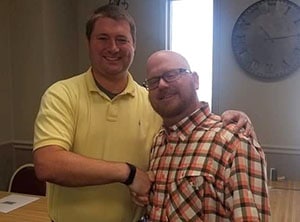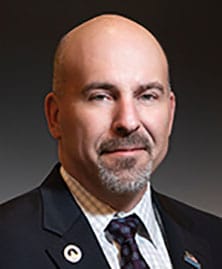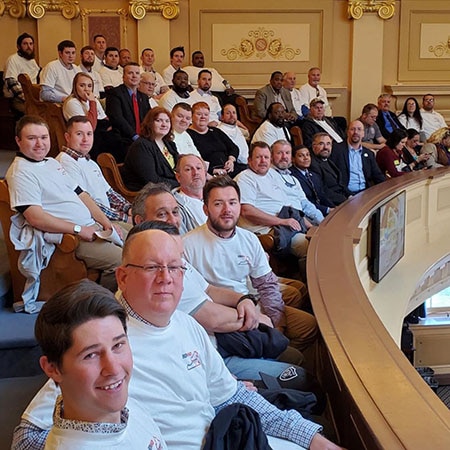A shooting aboard a Greyhound bus traveling between Los Angeles and San Francisco shows how passenger and operator security for ground transportation is more vulnerable when compared to air travel, The Associated Press reported.
One passenger lost her life and five other people were wounded, two critically, in the shooting that happened as the bus was moving on Interstate 5 near the small mountain community of Lebec, Calif., early Monday, Feb. 3. The suspect, a Maryland man, was restrained by passengers and arrested by authorities.
“Anyone determined to carry out an attack on ground transportation faces few, if any, security checks,” the AP report stated.
The report mentions that more than 30 million people in the U.S. use ground transportation daily while 3 million fly. But spending on security for ground transportation such as passenger trains, subways, light rail and buses is dwarfed by spending on air transportation security. An estimate from a former U.S. representative mentioned that after the Sept. 11, 2001, terrorist attacks that security for buses, trains, subways and ferries combined was outspent by air security by more than $20 billion.
Los Angeles County Metropolitan Transit Agency in conjunction with the Transportation Security Administration (TSA) is enacting security devices that scan for weapons and explosives, the first in the nation to do so, AP reported.
But duplicating the level of security that exists at the nation’s airports would be a difficult task for ground transportation providers nationwide, AP stated.
“As it is now, drivers and passengers are the de facto, frontline security when violence breaks out on buses,” the report stated.
Read the entire article from The Associated Press.
Author: bnagy
The efforts of a two-person crew in East St. Paul, Minn., helped to save a wandering five-year-old girl and reunite her with her family.
Near midnight Saturday, Feb. 1, SMART Transportation Division Local 1293 member Jarrod Campbell and BLET member Angela Knutson were operating a Union Pacific train through East St. Paul when they spotted something unusual alongside the tracks.
The shape looked strange to them, so Knutson stopped the train, and Campbell grabbed his lantern and left the cab to investigate.
Walking back, he discovered a five-year-old girl wearing a light jacket. She wasn’t wearing a hat or mittens and her sneakers were filled with snow.
“I introduced myself to her,” Campbell said. “She said that her name was Zoey and that she was cold and wanted her mom.”
The conductor out of the Altoona, Wis., local picked Zoey up and asked her if she would want to come into the locomotive where it was warm so she could meet Angela.
“She gave me a big hug and said thank you,” Campbell said.
Campbell carried Zoey through the snow and they went into the cab. There Campbell and Knutson comforted her by wrapping her in Campbell’s coat, giving her a spare pair of Knutson’s socks, using hand warmers to stave off the early signs of hypothermia and keeping her calm until EMS crews could arrive.
She had been reported missing to police about 45 minutes to a half-hour before the crew found her, Campbell later learned. The temperature was about 40 degrees Fahrenheit, and he said there was still eight to 10 inches of snow on the ground there.
The combined efforts of both crewmembers saved the girl from a possibly life-threatening situation at a time when rail carriers are looking to cut the conductor position from the cab in favor of technologies such as Positive Train Control. The carriers and Federal Railroad Administration argue that no data exists proving that a two-person crew is any safer than a single-person crew.
Zoey’s family would probably differ on that.
“It’s just miraculous that we were able to see her or find her,” Campbell said. “It sure wasn’t Positive Train Control that stopped and saved this girl.”
Both Campbell and Knutson told the story of the girl’s rescue to the Fox 9 television station in Minneapolis-St. Paul and brought a teddy bear to share with the girl.
“Let her know that we’re glad she’s doing good,” Campbell told reporter Christina Palladino.
Federal agencies have announced their random drug testing rates for the new calendar year.
In December, the Federal Motor Carrier Safety Administration (FMCSA) announced a test rate increase from 25 percent to 50 percent of the average number of driver positions because of an increased number of positive test results in 2018.
In January, the Federal Transit Administration (FTA) announced that the minimum random drug testing rate will remain unchanged at 50 percent.
The Federal Railroad Administration’s minimum drug test rate remains at 25 percent for workers, excluding maintenance-of-way employees.
The random alcohol testing rate has been set for all three agencies at 10 percent.
Railroad maintenance-of-way employees are tested at a higher rate: 50 percent for drugs and 25 percent for alcohol.
Click here for a chart from DOT detailing the 2020 random testing rates.
A two-person crew bill has been introduced in the Missouri Legislature, and we’ll need the support of SMART members in the region to help get the legislation passed.
H.B. 2229 was introduced January 16 by state Rep. Jim Neely (District 8), a Republican who is also a medical doctor. The bill, a joint effort of SMART-TD and the Brotherhood of Locomotive Engineers and Trainmen, has had two readings by members of the House and now sits on the desk of Speaker Elijah Haahr awaiting a committee assignment so a hearing can take place.
“We need your help to pressure Speaker Haahr to assign H.B. 2229 to a committee and move it forward,” SMART-TD Missouri State Legislative Director Jason Hayden said. “Phone calls and emails into his office asking him to move this bill are what we need. Calls and emails to your representative to explain the two-person crew issue are also very important.”
Speaker Haahr’s office phone number is 573-751-2210. His email address is Elijah.Haahr@house.mo.gov.
Hayden wanted to give special credit to Stacey Garton, the wife of BNSF conductor Glen Garton of TD Local 259 in St. Joseph, Mo. Her efforts and the grassroots support given by fellow members of the Facebook page Fight for Two Person Crews helped her to approach Neely. She then connected Hayden and BLET State Legislative Chairman Calvin Groose with Neely so that the bill could be finalized before introduction.
“It was not hard for Rep. Neely to understand the grave situation it not only puts the single employee in but also the general public,” Hayden said about the dangers of one-person freight operations. “He was actually not on my radar as someone to approach about carrying the bill for us. But this situation goes to show allies can come from the most unexpected places. It really is all about how an issue touches someone.”
A great show of support from union members and their family and friends in Missouri in contacting their state legislators will help to show the Show Me State that H.B. 2229 matters for the continued safety of both rail workers and for the public.
Members wanting to assist in the effort to get the word out about this important legislation and to have their voices heard can contact Hayden at director@smartmoslb.org.
“We have the numbers to make this happen, we just need your help to accomplish it,” he said.
Virginia’s House of Delegates on Wednesday passed H.B. 440, a two-person freight crew bill, by a 61-37 vote, with one delegate abstaining.
The bill now moves on to the state’s Senate.
“We’ve hit third base,” SMART TD Virginia Legislative Director Ronnie Hobbs said. “It’s going to take some work from all of us, but we’re getting to work to bring it home to the Governor’s desk.”
There was a strong show of support in the state Capitol for the bill by members from both the Sheet Metal and TD sides. After the passage was announced by House Speaker Eileen Filler-Corn, cheers from supporters filled the chamber.
H.B. 440 levies fines on freight carriers who do not operate with two crew members in the cab with exceptions for hostler or yard service.
Hobbs said the effort that got the bill through the House will need to be sustained and more support from members will be needed as work continues in the state Senate.
“We had a great turnout and filled the chamber,” Hobbs said. “There has been great effort from members and retirees who have been reaching out to officials and letting them know about how two people are needed on the crew. If we keep this up, the bill will pass.”
Hobbs said that he will keep members informed as the bill progresses and thanks everyone for their strong support. Contact Hobbs at rhobbs1313@gmail.com for more details on how to show your support.
H.B. 440, which was introduced by Delegate Steve E. Heretick of District 79, passed the House’s Committee on Rail and Commerce Jan. 16 by a 13-8 vote.




